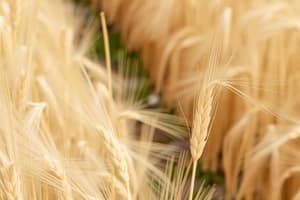Podcast
Questions and Answers
What family does barley belong to?
What family does barley belong to?
- Poaceae (correct)
- Asteraceae
- Fabaceae
- Brassicaceae
What is the ideal moisture content for malting barley at harvest?
What is the ideal moisture content for malting barley at harvest?
- 12%
- 14% (correct)
- 16%
- 18%
What are the two main uses for barley?
What are the two main uses for barley?
- Brewing and distilling
- Malting and feeding (correct)
- Baking and malting
- Animal feed and alcohol production
What type of soil is barley best suited for?
What type of soil is barley best suited for?
What are tramlines used for in barley cultivation?
What are tramlines used for in barley cultivation?
At what depth should barley seeds typically be sown?
At what depth should barley seeds typically be sown?
What is thousand grain weight used for?
What is thousand grain weight used for?
Which growth stage of barley follows stem extension?
Which growth stage of barley follows stem extension?
What percentage of fertiliser should be spread when sowing spring barley in a split dressing?
What percentage of fertiliser should be spread when sowing spring barley in a split dressing?
Which two nutrients should be spread with malting barley?
Which two nutrients should be spread with malting barley?
What is meant by lodging in cereal crops?
What is meant by lodging in cereal crops?
When is winter barley harvested and what is its typical yield?
When is winter barley harvested and what is its typical yield?
What two main pests are associated with barley and how do they affect the crop?
What two main pests are associated with barley and how do they affect the crop?
Flashcards are hidden until you start studying
Study Notes
Barley Classification and Varieties
- Barley belongs to the Poaceae family.
- There are two main types of barley varieties: winter barley and spring barley.
- Barley can be sown in two-row or six-row arrangements; spring planting uses the two-row method.
Uses of Barley
- Malting barley is primarily used to produce alcohol for the brewing and distilling industries.
- Feeding barley is utilized to create animal rations.
- Barley straw serves as animal bedding and feed.
Harvest and Moisture Content
- Ideal moisture content for malting barley at harvest is 14%.
- Feeding barley should have a moisture content of 18% or lower at harvest.
Optimal Growing Conditions
- Barley thrives in bright, sunny, and warm conditions.
Growth Stages of Barley
- Five growth stages:
- Germination
- Tillering
- Stem extension
- Heading
- Ripening
Phyllochron and Influencing Factors
- Phyllochron is the time between the emergence of two successive leaves.
- It is influenced by the sowing date of the chosen seed variety.
Choosing Cereal Varieties
- Factors for selecting cereal varieties include relative yield, straw shortness, lodging resistance, straw breakdown, earliness of ripening, and disease resistance.
Thousand Grain Weight (TGW)
- Thousand grain weight measures the mass of 1,000 grains in grams, essential for calculating seeding rates.
Key Factors Influencing Barley Production
- Influential factors: soil type, seedbed preparation, sowing time, seeding rate, and fertilizer application.
- Barley is best suited to well-drained, deep/sandy loam, grey-brown podzols, or brown earths.
- Ideal soil pH for barley growth is between 6 and 6.5.
Planting Schedule
- Winter barley is best planted in autumn (September).
- Spring barley should be planted from February to April.
Seed Sowing Techniques
- Rolling is performed to ensure good seed contact with the soil.
- Seeds are sown using a combine drill, with a typical drill distance of 14-16 cm.
- Seeds should be sown at a depth of 3-5 cm.
- Seeding rate for winter barley ranges from 160-200 kg/ha, typically higher than that for spring barley.
Tramlines and Fertilizer Application
- Tramlines are established parallel lines that allow for access to crops for fertilizer spreading without damaging the plants.
- Soil tests are conducted to determine the suitability and application rates of fertilizers.
Seeding Rate Calculation
- The seeding rate can be calculated using the formula: target population multiplied by TGW divided by expected establishment percentage.
Fertiliser Application for Barley
- When sowing spring barley using a split dressing, 30% of the fertiliser should be applied at the time of sowing.
Nutrient Requirements for Malting Barley
- Malting barley should be fertilised with phosphorus and potassium to enhance growth and quality.
Understanding Lodging
- Lodging refers to cereal crops, particularly barley, bending over, which causes them to lie flat and complicates harvesting.
- Lodging negatively impacts yield potential and can be influenced by adverse weather conditions or improper fertiliser application.
Harvest Timing and Yields
- Winter barley is typically harvested in July, yielding 7 to 9 tonnes per hectare, alongside an average straw yield of 4.2 tonnes per hectare.
- Spring barley is harvested in August, producing a yield of 6 to 7 tonnes per hectare, with straw yield around 3.6 tonnes per hectare.
Pests Affecting Barley
- The primary pests associated with barley cultivation are leatherjackets and click beetles.
- These pests can significantly reduce crop yield, affecting overall production.
Barley and Grass Rotation
- Barley should not be cultivated in rotation with grass, indicating a preference for different cropping strategies for optimal yield.
Studying That Suits You
Use AI to generate personalized quizzes and flashcards to suit your learning preferences.




